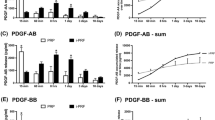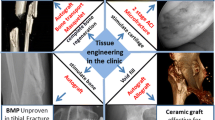Summary
Platelet-rich plasma (PRP) has been used to promote periodontal regeneration following the premise that constituent transforming growth factor-β1 (TGF-β1) and platelet-derived growth factor-AB will stimulate cell proliferation at the site of application. In previous studies, we demonstrated that PRP mimics TGF-β1 to modulate proliferation in a cell type-specific manner, that fibrin clot formation by PRP upregulates type I collagen, and that an unidentified factor(s) in PRP increases alkaline phosphatase (ALP) activity in human periodontal ligament (PDL) cell cultures. We have now examined the effects of PRP on in vitro mineralization. Platelet-rich plasma and PDL cells were prepared from human adult volunteers or rats. After 20 d of continuous treatment with PRP in dexamethazone (Dex)-containing osteogenic medium, PRP time dependently promoted mineralization by rat PDL cells but failed to fully induce the osteoblastic phenotype. Furthermore, when human PDL cells were induced to increase ALP activity in osteogenic medium that lacked Dex, a condition that should delay (or suppress) osteoblastic differentiation, transmission electron microscopy revealed that mineralized spicules were initially deposited onto PRP-derived platelet aggregates. Taken together with our previous data, these findings suggest that PRP provides platelet aggregates as nuclei to initiate mineralization while stimulating PDL cell proliferation, differentiation, and collagen production. The combination of these effects may effectively mediate PRP's ability to promote regeneration of periodontal tissue, including skeletal tissue, at the site of injury.
Similar content being viewed by others
References
Andrianarivo, A. G.; Robinson, J. A.; Mann, K. G., Tracy, R. P. Growth on type I collagen promotes expression the osteoblastic phenotype in human osteosarcoma MG-63 cells. J. Cell. Physiol. 152:256–265; 1992.
Arceo, N.; Sauk, J. J.; Moehring, J. et al Human periodontal cells initiate mineral-like nodules in vitro. J. Periodontol. 62:499–503; 1991.
Kawase, T.; Okuda, K.; Saito, Y.; Yoshie, H. In In vitro evidence that the biological effects of platelet-rich plasma on periodontal ligament cells is not mediated solely by constituent transforming-growth factor-β or platelet-derived growth factor. J. Periodontol. 76:760–767; 2005.
Kawase, T.; Okuda, K.; Wolff, L. F.; Yoshie, H. Platelet-rich plasma-derived fibrin clot formation stimulates collagen synthesis in periodontal ligament and osteoblastic cells in vitro. J. Periodontol. 74:858–864; 2003.
Lynch, M.; Stein, J. L.; Stein, G. S.; Lian, J. The influence of type I collagen on the development and maintenance of the osteoblast phenotype in primary and passaged rat calvarial osteoblasts: modification of expression of genes supporting cell growth, adhesion, and extracellular matrix mineralization. Exp. Cell Res. 216:35–45; 1995.
Marsh, M. E.; Munne, A. M.; Vogel, J. J.; Cui, Y.; Franceschi, R. T.. Mineralization of bone-like extracellular matrix in the absence of functional osteoblasts. J. Bone Miner. Res. 10:1635–1643; 1995.
Okuda, K.; Kawase, T.; Momose, M., et al. Platelet-rich plasma contains high levels of platelet-derived growth factor and transforming growth factor-β and modulates the proliferation of periodontally related cells in vitro. J. Periodontol. 74:849–857: 2003.
Okuda, K.; Tai, H.; Tanabe, K., et al Platelet-rich plasma combined with a porous hydroxyapatite graft for the treatment of intrabony periodontal defects in humans: a comparative controlled clinical study. J. Periodontol. 76:890–898: 2005.
Reznikoff, C. A.; Loretz, L. J.; Pesciotta, D. M.; Oberley, T. D.; Ignjatovic, M. M. Growth kinetics and differentiation in vitro of normal human uroepithelial cells on collagen gel substrates in defined medium. J. Cell. Physiol. 131:285–301; 1987.
Rocha, V.; Ringo, D. L.; Read, D. B. Casein production during differentiation of mammary epithelial cells in collagen gel culture. Exp. Cell Res. 159:201–210; 1985.
Sano, A.; Maeda, M.; Nagahara, S., et al. Atelocollagen for protein and gene delivery. Adv. Drug Deliv. Rev. 55:1651–1677; 2003.
Author information
Authors and Affiliations
Rights and permissions
About this article
Cite this article
Kawase, T., Okuda, K., Saito, Y. et al. Platelet-rich plasma provides nucleus for mineralization in cultures of partially differentiated periodontal ligament cells. In Vitro Cell.Dev.Biol.-Animal 41, 171–176 (2005). https://doi.org/10.1290/0502013.1
Received:
Revised:
Issue Date:
DOI: https://doi.org/10.1290/0502013.1




